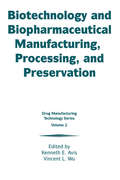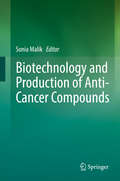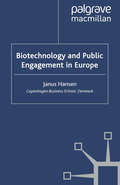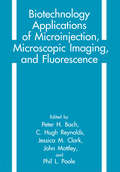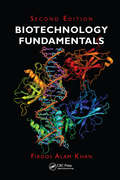- Table View
- List View
Biotechnology: the Science, the Products, the Government, the Business (Drugs and the Pharmaceutical Sciences)
by Ronald P. EvensThe over-riding premise for biotechnology in this book is bringing novel products to market to substantially advance patient care and disease mitigation. Biotechnology, over its relatively brief existence of 40 years, has experienced a mercurial growth. The vast educational need for biotechnology information in this rapidly burgeoning field is a basic rationale here. However a more prominent underpinning is that, bringing biotech products to market for patient care involves success in the following four areas of engagement simultaneously - scientific advances for healthcare technologies, novel and varied products for untreated diseases, regulatory authorities, and biotech companies. Features Comprehensive coverage of biotechnology science topics used in development and manufacturing Addresses all the scientific technologies within biotechnology responsible for products on the market and the pipeline Presents business issues such as marketing and sales of the products, as well as companies engaged, and how biotech business has evolved
Biotechnology: the Science, the Products, the Government, the Business (Drugs and the Pharmaceutical Sciences)
by Ronald P. EvensThe over-riding premise for biotechnology in this book is bringing novel products to market to substantially advance patient care and disease mitigation. Biotechnology, over its relatively brief existence of 40 years, has experienced a mercurial growth. The vast educational need for biotechnology information in this rapidly burgeoning field is a basic rationale here. However a more prominent underpinning is that, bringing biotech products to market for patient care involves success in the following four areas of engagement simultaneously - scientific advances for healthcare technologies, novel and varied products for untreated diseases, regulatory authorities, and biotech companies. Features Comprehensive coverage of biotechnology science topics used in development and manufacturing Addresses all the scientific technologies within biotechnology responsible for products on the market and the pipeline Presents business issues such as marketing and sales of the products, as well as companies engaged, and how biotech business has evolved
Biotechnology: A Comprehensive Training Guide for the Biotechnology Industry
by Syed Imtiaz Haider Anika AshtokAll manufacturing companies face the daunting task of designing an employee training matrix that meets the gamut of national and international regulatory standards. Answering the call for a one-stop training resource that focuses exclusively on this multi-faceted, high-tech industry, Biotechnology: A Comprehensive Training Guide for the Biotechnolo
Biotechnology: A Hope or a Threat? (International Labour Office)
by Michael Lipton Iftikhar AhmedInvestigates current applications of biotechnology in developing countries and their impact on the rural poor. Can biotechnologies be specifically designed and deliberately released to alleviate rural poverty, or will they accentuate existing inequalities?
Biotechnology and Bioactive Polymers
by Charles E. Carraher Jr. C. G. GebeleinSome have predicted that the coming several decades will be the decades of "biotechnology," wherein cancer, birth defects, life span increases, cosmetics, biodegradation, oil spills and exploration, solid waste disposal, and almost every aspect of our material life will be affected by this new area of science. There will also be an extension of emphasis on giant molecules: DNA, enzymes, polysaccharides, lignins, proteins, hemoglobin, and many others. Biotechnology has been defined in various ways. In one sense, this field is older than human history and references to the human use of biotechnology-derived materials can be found in the oldest human writings, such as the Bible. In this book, biotechnology refers to the direct usage of naturally occurring materials or their uses as a feedstock, including the associated biological activities and applications of these materials. Bioactive polymers, on the other hand, are polymers which exert some type of activity on living organisms. These polymers are used in agriculture, controlled release systems, medicine and many other areas. The papers in this book describe polymers which essentially combine features of biotechnology and bioactivity.
Biotechnology and Bioforensics: New Trends (SpringerBriefs in Applied Sciences and Technology)
by Amit KumarThis Brief covers broad areas of Applied Biology specifically into the domains of Biotechnology/Biomedicine and Forensic Science. Chapters included here would also explain the role of bioinformatics in protein and gene characterization, modeling of the protein structure, survey related to the chromosomal effect on Human Disorders like Diabetes and Cardiac Problems. This Brief is full of Innovative Literature like Use of Microbes in Electricity Production, Brain connection to Type 2 Diabetes etc. Interesting issues in Forensic biology and the aspects of Bioforensics like STR profiling of exhumed bones makes this brief truly useful and informative for Researchers. It also includes the advancements and new ideologies in understanding crop improvements & crop quality. This Brief witnesses Innovative Research related to the Bio and Agri software development too which are capable of accelerating Insilico biological data analysis.
Biotechnology and Biological Sciences: Proceedings of the 3rd International Conference of Biotechnology and Biological Sciences (BIOSPECTRUM 2019), August 8-10, 2019, Kolkata, India
by Ramkrishna Sen Susmita Mukherjee Rajashree Paul Rajiv NarulaThe application of Biotechnology dates back to the early era of civilization, when people first started to cultivate food crops. While the early applications are certainly still relevant, modern biotechnology is primarily associated with molecular biology, cloning and genetic engineering not only to increase the yield and to improve the quality of the crop but also its potential impact has touched upon virtually all domains of human interactions. Within the last 50 years, several key scientific discoveries revolutionized the biological sciences that facilitated the rapid growth of the biotechnology industry. 'Biotechnology and Biological Sciences III' contains the contributions presented at the 3rd International Conference on Biotechnology and Biological Sciences (BIOSPECTRUM 2019, Kolkata, India, 8-10 August 2019). The papers discuss various aspects of Biotechnology such as: microbial biotechnology, bioinformatics and drug designing, innovations in pharmaceutical industries and food processing industries, bioremediation, nano-biotechnology, and molecular-genetics, and will be of interest to academics and professionals involved or interested in these subject areas.
Biotechnology and Biopharmaceutical Manufacturing, Processing, and Preservation
by Kenneth E. Avis Vincent L. WuIn this unique book, experts describe practices applicable to the large-scale processing of biotechnological products. Beginning with processing and bulk storage preservation techniques, the book provides strategies for improving efficiency of process campaigns of multiple products and manufacturing facilities for such processing techniques. Large-scale chromatography for the purification of biomolecules in manufacturing and lyophilization of protein pharmaceuticals are discussed. Includes a case study on blow-fill-seal processing technology and a chapter on economic and cost factors for bioprocess engineering.
Biotechnology and Biopharmaceutical Manufacturing, Processing, and Preservation
by Kenneth E. Avis and Vincent L. WuIn this unique book, experts describe practices applicable to the large-scale processing of biotechnological products. Beginning with processing and bulk storage preservation techniques, the book provides strategies for improving efficiency of process campaigns of multiple products and manufacturing facilities for such processing techniques. Large-scale chromatography for the purification of biomolecules in manufacturing and lyophilization of protein pharmaceuticals are discussed. Includes a case study on blow-fill-seal processing technology and a chapter on economic and cost factors for bioprocess engineering.
Biotechnology and Intellectual Property Rights: Legal and Social Implications
by Kshitij Kumar SinghThis book offers a valuable contribution to contemporary legal literature, providing deep insights into the interface between law and genetics, highlighting emerging issues and providing meaningful solutions to current problems. It will be of interest to a broad readership, including academics, lawyers, policy makers and scholars engaged in interdisciplinary research.In the context of examining and analyzing the legal and social implications arising from the recent conjunction of biotechnology and intellectual property rights, the book particularly focuses on human genes and gene variations. Emphasis is placed on “patent law,” as a considerable percentage of genetic inventions are covered by patents. The book presents a comparative and critical examination of patent laws and practices related to biotechnology patents in the United States, Canada, European Union and India, in order to gather the common issues and the differences between them. The international patent approach regarding biotechnology is also analyzed in light of the constant conflict between differentiation and harmonization of patent laws. The book highlights the potential gaps and uncertainties as to the scope of numerous terms such as invention, microorganisms, microbiological processes, and essential biological processes under TRIPS. Also analyzed are the social and policy implications of patents relating to genetic research tools and genetic testing. The intricacies involved in providing effective intellectual property protection to bioinformatics and genomic databases are also examined. Bearing in mind the collaborative nature of bioinformatics and genomic databases, the book evaluates the pros and cons of open biotechnology and assesses the implications of extending intellectual property rights to human genetic resources, before explaining the ownership puzzle concerning human genetic material used in genetic research.
Biotechnology and Pharmacy
by J. M. Pezzuto M. E. Johnson H. R. ManasseBiotechnology and Pharmacy offers a unique overview of the principles of biotechnology and their applications in the pharmaceutical sciences. The book assumes a basic knowledge of biology and chemistry and was written as a text suitable for students of pharmacy or other health sciences. The first part of the book describes the basic elements of biotechnology, such as recombinant DNA and monoclonal antibody technology; the second part comprehensively covers applications of biotechnology in the diagnosis and treatment of disease; and the final part offers a practical discussion of how biotechnology products will affect the practice of pharmacy. Microbiologists, biochemists, and medicinal chemists will also find this book to be a valuable reference.
Biotechnology and Production of Anti-Cancer Compounds
by Sonia MalikThis book discusses cancers and the resurgence of public interest in plant-based and herbal drugs. It also describes ways of obtaining anti-cancer drugs from plants and improving their production using biotechnological techniques. It presents methods such as cell culture, shoot and root culture, hairy root culture, purification of plant raw materials, genetic engineering, optimization of culture conditions as well as metabolic engineering with examples of successes like taxol, shikonin, ingenol mebutate and podophylotoxin. In addition, it describes the applications and limitations of large-scale production of anti-cancer compounds using biotechnological means. Lastly, it discusses future economical and eco-friendly strategies for obtaining anti-cancer compounds using biotechnology.
Biotechnology and Public Engagement in Europe
by J. HansenProviding a comparison the most important instances of public engagement with biotechnology in Europe in recent years, this book provides a theoretically reflected and empirically grounded study of the opportunities and obstacles for a thorough democratization of technological development through processes of public engagement.
Biotechnology and the Human Genome: Innovations and Impact (Basic Life Sciences #46)
by Avril D. Woodhead Benjamin J. BarnhartThis book is based on the proceedings of the Science Writers Workshop on "Biotechnology and the Human Genome: Innovations and Impacts" held at the Brookhaven National Laboratory on September 14-16, 1987. The aim of this workshop which was sponsored by the Office of Health and Environmental Research of the Department of Energy (DOE) was to provide a forum in which science writers, reporters and other interested individuals could gain a firsthand knowledge about the scope and direction of the human genome initi ative and its supportive technologies. The speakers were leaders working in scientific disciplines that are either integral parts of the Department's genome project or that represent important ancillary science. The Department of Energy's human genome initiative is a logical ex tension of its long term commitment to investigating genetic damage from exposures to radiations and energy-related chemicals. It will exploit comp utational, engineering and biological capabilities within and as well as outside the DOE national laboratories to develop the technologies and re sources which will lead to a complete description of the human genome at the molecular level. Knowledge of the entire human genetic map and the genomic sequence will allow investigators to more rapidly and effectively identify genes involved in genetic diseases, individual variabilities including radi ation sensitivities, and physiological processes, as well as to make unpre cedented inroads into evolutionary relationships.
Biotechnology Applications of Microinjection, Microscopic Imaging, and Fluorescence
by Peter H. Bach C. H. Reynolds J. M. Clark J. Mottley P. L. PooleIndividual cells behave in surpnsmg ways that cannot be deduced from the averaged results of an organ as assessed by the use of conventional biochemical methods. Thus multicellular plant and animals systems are being investigated by an increasing array of histochemical and cytochemical techniques based on general chemical or specific immunological interactions to identify structural materials and to assess biological activities. In recent years there has been an increasing range of fluorescent probes, along with advanced computerised imaging and analysis techniques, which allows the behaviour of individual living cells to be followed in considerable detail. The parallel use of microinjection, microelectrodes and patch-clamping provides additional information about cells and their responses. Recombinant DNA technology has highlighted the desirability and the power of microinjecting defined materials into specific cells and so manipulating their fundamental biochemistry. New hypotheses are being tested which will form the cornerstone of future developments across the whole spectrum of biotechnology. The First European Workshop on Biotechnology Applications of Microinjection, Microscopic Imaging and Fluorescence was run at the University of East London, U.K, 21st-24th April, 1992 with the objective of bringing together a diverse group of individuals who were using these state-of-the-art applications for biotechnological exploration. A novel feature of the meeting was paiticipation by instrument manufacturers in the programme: there were hands-on workshops (where living cells could be examined), combined with the poster sessions.
Biotechnology for Agro-Industrial Residues Utilisation: Utilisation of Agro-Residues
by Poonam Singh-Nee Nigam Ashok PandeyResidues from agriculture and the food industry consist of many and varied wastes, in total accounting for over 250 million tonnes of waste per year in the UK alone. Biotechnological processing of these residues would allow these waste products to be used as a resource, with tremendous potential. An extensive range of valuable and usable products can be recovered from what was previously considered waste: including fuels, feeds and pharmaceutical products. In this way Biotechnology can offer many viable alternatives to the disposal of agricultural waste, producing several new products in the process. This book presents up-to-date information on a biotechnology approach for the utilisation of agro-industrial residues, presenting chapters with detailed information on materials and bioconversion technology to obtain products of economic importance: The production of industrial products using agro-industrial residues as substrates The biotechnological potential of agro-industrial residues for bioprocesses Enzymes degrading agro-industrial residues and their production Bioconversion of agro-industrial residues. Written by experts in Biotechnological processing of Agro-Industrial Residues, this book will provide useful information for academic researchers and industry scientists working in biotechnology, waste management, agriculture and the food industry.
Biotechnology for Biomedical Engineers (Principles and Applications in Engineering)
by Martin L. Yarmush Mehmet Toner Robert Plonsey Joseph D. BronzinoWith the advent of recombinant DNA technology, monoclonal antibody technology, and new technologies for studying and handling cells and tissues, the field of biotechnology has undergone a tremendous resurgence in a wide range of applications pertinent to industry, medicine, and science in general. A volume in the Principles and Applications in Engi
Biotechnology for Biomedical Engineers (Principles and Applications in Engineering)
by Martin L. Yarmush Mehmet Toner Robert Plonsey Joseph D. BronzinoWith the advent of recombinant DNA technology, monoclonal antibody technology, and new technologies for studying and handling cells and tissues, the field of biotechnology has undergone a tremendous resurgence in a wide range of applications pertinent to industry, medicine, and science in general. A volume in the Principles and Applications in Engi
Biotechnology for Medicinal Plants: Micropropagation and Improvement
by Suman Chandra, Hemant Lata and Ajit VarmaPlant-based medicines play an important role in all cultures, and have been indispensable in maintaining health and combating diseases. The identification of active principles and their molecular targets from traditional medicine provides an enormous opportunity for drug development. Using modern biotechnology, plants with specific chemical compositions can be mass propagated and genetically improved for the extraction of bulk active pharmaceuticals. Although there has been significant progress in the use of biotechnology, using tissue cultures and genetic transformation to investigate and alter pathways for the biosynthesis of target metabolites, there are many challenges involved in bringing plants from the laboratory to successful commercial cultivation. This book presents the latest advances in the development of medicinal drugs, including topics such as plant tissue cultures, secondary metabolite production, metabolomics, metabolic engineering, bioinformatics and future biotechnological directions.
Biotechnology for Waste Biomass Utilization
by Prakash K. Sarangi Latika BhatiaThis volume focuses on how waste biomass can be transformed into useful biomaterials, food and feed, fuel, and chemicals by using various processes such as chemical, physical, thermal, biological, and biotechnological procedures. Biomass from biowastes, such as agriculture crop residues, wood processing residues, forest residues, food waste, industrial waste, and municipal solid waste, have emerged as potential substrates for bioenergy production. This volume explores the key features of biotechnology for waste biomass utilization, presenting scientific and technical literature on sustainable waste biomass management as well as for biomass conversion for biofuels, chemicals, and other new commercial products. It discusses a variety of novel biotechnical applications and interventions, including microbial fermentation and anaerobic digestion, biotechnological modes of xylooligosaccharides production, multifaceted utilization of microalgal biomass, vermiculture and vermicomposting, and more. Key features: Provides the most recent information about waste biomass utilization for the production of biofuels and biochemicals Shows a wide range of novel technologies in the field of biotechnology towards waste biomass utilization Focuses on the utilization of microbial resources for waste biomass conversion into value-added products Explores methods for food wastes and crop wastes conversion into biofuels and biochemicals Provides the scientific information describing various examples and case studies which aid gaining knowledge to researchers and academicians With chapters from eminent researchers who have significant global experience in the field of waste biomass management, this volume delivers a wealth of valuable information for researchers involved in bioenergy utilization. It will also be an essential source for academicians, researchers, economists, policymakers, and policy analysts.
Biotechnology for Waste Biomass Utilization
by Prakash Kumar Sarangi Latika BhatiaThis volume focuses on how waste biomass can be transformed into useful biomaterials, food and feed, fuel, and chemicals by using various processes such as chemical, physical, thermal, biological, and biotechnological procedures. Biomass from biowastes, such as agriculture crop residues, wood processing residues, forest residues, food waste, industrial waste, and municipal solid waste, have emerged as potential substrates for bioenergy production. This volume explores the key features of biotechnology for waste biomass utilization, presenting scientific and technical literature on sustainable waste biomass management as well as for biomass conversion for biofuels, chemicals, and other new commercial products. It discusses a variety of novel biotechnical applications and interventions, including microbial fermentation and anaerobic digestion, biotechnological modes of xylooligosaccharides production, multifaceted utilization of microalgal biomass, vermiculture and vermicomposting, and more. Key features: Provides the most recent information about waste biomass utilization for the production of biofuels and biochemicals Shows a wide range of novel technologies in the field of biotechnology towards waste biomass utilization Focuses on the utilization of microbial resources for waste biomass conversion into value-added products Explores methods for food wastes and crop wastes conversion into biofuels and biochemicals Provides the scientific information describing various examples and case studies which aid gaining knowledge to researchers and academicians With chapters from eminent researchers who have significant global experience in the field of waste biomass management, this volume delivers a wealth of valuable information for researchers involved in bioenergy utilization. It will also be an essential source for academicians, researchers, economists, policymakers, and policy analysts.
Biotechnology Fundamentals
by Firdos Alam KhanA single source reference covering every aspect of biotechnology, Biotechnology Fundamentals, Second Edition breaks down the basic fundamentals of this discipline, and highlights both conventional and modern approaches unique to the industry. In addition to recent advances and updates relevant to the first edition, the revised work also covers ethics in biotechnology and discusses career possibilities in this growing field. The book begins with a basic introduction of biotechnology, moves on to more complex topics, and provides relevant examples along the way. Each chapter begins with a brief summary, is illustrated by simple line diagrams, pictures, and tables, and ends with a question session, an assignment, and field trip information. The author also discusses the connection between plant breeding, cheese making, in vitro fertilization, alcohol fermentation, and biotechnology. Comprised of 15 chapters, this seminal work offers in-depth coverage of topics that include: Genes and Genomics Proteins and Proteomics Recombinant DNA Technology Microbial Biotechnology Agricultural Biotechnology Animal Biotechnology Environmental Biotechnology Medical Biotechnology Nanobiotechnology Product Development in Biotechnology Industrial Biotechnology Ethics in Biotechnology Careers in Biotechnology Laboratory Tutorials Biotechnology Fundamentals, Second Edition provides a complete introduction of biotechnology to students taking biotechnology or life science courses and offers a detailed overview of the fundamentals to anyone in need of comprehensive information on the subject.
Biotechnology Fundamentals
by Firdos Alam KhanA single source reference covering every aspect of biotechnology, Biotechnology Fundamentals, Second Edition breaks down the basic fundamentals of this discipline, and highlights both conventional and modern approaches unique to the industry. In addition to recent advances and updates relevant to the first edition, the revised work also covers ethics in biotechnology and discusses career possibilities in this growing field. The book begins with a basic introduction of biotechnology, moves on to more complex topics, and provides relevant examples along the way. Each chapter begins with a brief summary, is illustrated by simple line diagrams, pictures, and tables, and ends with a question session, an assignment, and field trip information. The author also discusses the connection between plant breeding, cheese making, in vitro fertilization, alcohol fermentation, and biotechnology. Comprised of 15 chapters, this seminal work offers in-depth coverage of topics that include: Genes and Genomics Proteins and Proteomics Recombinant DNA Technology Microbial Biotechnology Agricultural Biotechnology Animal Biotechnology Environmental Biotechnology Medical Biotechnology Nanobiotechnology Product Development in Biotechnology Industrial Biotechnology Ethics in Biotechnology Careers in Biotechnology Laboratory Tutorials Biotechnology Fundamentals, Second Edition provides a complete introduction of biotechnology to students taking biotechnology or life science courses and offers a detailed overview of the fundamentals to anyone in need of comprehensive information on the subject.
Biotechnology Fundamentals Third Edition
by Firdos Alam KhanAfter successful launching of first and second editions of Biotechnology Fundamentals, we thought let us find out the feedbacks from our esteemed readers, faculty members, and students about their experiences and after receiving their suggestions and recommendation we thought it would be great idea to write 3rd edition of the book. Being a teacher of biotechnology, I always wanted a book which covers all aspects of biotechnology, right from basics to applied and industrial levels. In our previous editions, we have included all topics of biotechnology which are important and fundamentals for students learning. One of the important highlights of the book that it has dedicated chapter for the career aspects of biotechnology and you may agree that many students eager to know what are career prospects they have in biotechnology. There are a great number of textbooks available that deal with molecular biotechnology, microbial biotechnology, industrial biotechnology, agricultural biotechnology, medical biotechnology, or animal biotechnology independently; however, there is not a single book available that deals with all aspects of biotechnology in one book. Today the field of biotechnology is moving with lightening speed. It becomes very important to keep track of all those new information which affect the biotechnology field directly or indirectly. In this book, I have tried to include all the topics which are directly or indirectly related to fields of biotechnology. The book discusses both conventional and modern aspects of biotechnology with suitable examples and gives the impression that the field of biotechnology is there for ages with different names; you may call them plant breeding, cheese making, in vitro fertilization, alcohol fermentation is all the fruits of biotechnology. The primary aim of this book is to help the students to learn biotechnology with classical and modern approaches and take them from basic information to complex topics. There is a total of 21 chapters in this textbook covering topics ranging from an introduction to biotechnology, genes to genomics, protein to proteomics, recombinant DNA technology, microbial biotechnology, agricultural biotechnology, animal biotechnology, environmental biotechnology, medical biotechnology, nanobiotechnology, product development in biotechnology, industrial biotechnology, forensic science, regenerative medicine, biosimialars, synthetic biology, biomedical engineering, computational biology, ethics in biotechnology, careers in biotechnology, and laboratory tutorials. All chapters begin with a brief summary followed by text with suitable examples. Each chapter illustrated by simple line diagrams, pictures, and tables. Each chapter concludes with a question session, assignment, and field trip information. I have included laboratory tutorials as a separate chapter to expose the students to various laboratory techniques and laboratory protocols. This practical information would be an added advantage to the students while they learn the theoretical aspects of biotechnology.
Biotechnology Fundamentals Third Edition
by Firdos Alam KhanAfter successful launching of first and second editions of Biotechnology Fundamentals, we thought let us find out the feedbacks from our esteemed readers, faculty members, and students about their experiences and after receiving their suggestions and recommendation we thought it would be great idea to write 3rd edition of the book. Being a teacher of biotechnology, I always wanted a book which covers all aspects of biotechnology, right from basics to applied and industrial levels. In our previous editions, we have included all topics of biotechnology which are important and fundamentals for students learning. One of the important highlights of the book that it has dedicated chapter for the career aspects of biotechnology and you may agree that many students eager to know what are career prospects they have in biotechnology. There are a great number of textbooks available that deal with molecular biotechnology, microbial biotechnology, industrial biotechnology, agricultural biotechnology, medical biotechnology, or animal biotechnology independently; however, there is not a single book available that deals with all aspects of biotechnology in one book. Today the field of biotechnology is moving with lightening speed. It becomes very important to keep track of all those new information which affect the biotechnology field directly or indirectly. In this book, I have tried to include all the topics which are directly or indirectly related to fields of biotechnology. The book discusses both conventional and modern aspects of biotechnology with suitable examples and gives the impression that the field of biotechnology is there for ages with different names; you may call them plant breeding, cheese making, in vitro fertilization, alcohol fermentation is all the fruits of biotechnology. The primary aim of this book is to help the students to learn biotechnology with classical and modern approaches and take them from basic information to complex topics. There is a total of 21 chapters in this textbook covering topics ranging from an introduction to biotechnology, genes to genomics, protein to proteomics, recombinant DNA technology, microbial biotechnology, agricultural biotechnology, animal biotechnology, environmental biotechnology, medical biotechnology, nanobiotechnology, product development in biotechnology, industrial biotechnology, forensic science, regenerative medicine, biosimialars, synthetic biology, biomedical engineering, computational biology, ethics in biotechnology, careers in biotechnology, and laboratory tutorials. All chapters begin with a brief summary followed by text with suitable examples. Each chapter illustrated by simple line diagrams, pictures, and tables. Each chapter concludes with a question session, assignment, and field trip information. I have included laboratory tutorials as a separate chapter to expose the students to various laboratory techniques and laboratory protocols. This practical information would be an added advantage to the students while they learn the theoretical aspects of biotechnology.






